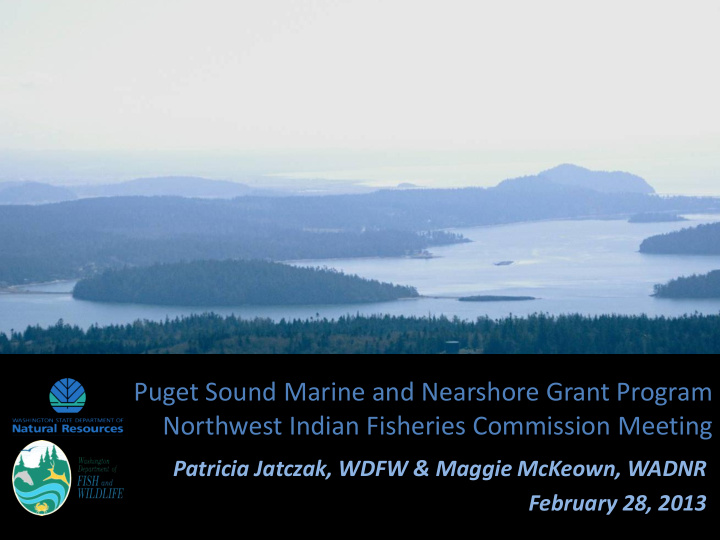



Puget Sound Marine and Nearshore Grant Program Northwest Indian Fisheries Commission Meeting Patricia Jatczak, WDFW & Maggie McKeown, WADNR February 28, 2013
Marine and Nearshore LO Funds actions that advance the Action Agenda & Habitat Strategic Initiative by protecting and restoring marine habitat and ecosystem functions Effective Regulation & Stewardship Capital Investment High Priority Threats: Oil Spills, Invasive Species Cross-Cutting Adaptive Management Puget Sound Marine and Nearshore Grant Program 2
Habitat Strategic Initiative Priorities of the Habitat Strategic Initiative, and Grants that Support Sub-Strategies and/or NTAs Sub- Strategy NTA Current LO Investments Round 4 Considerations Supporting local governments to adopt and Already supporting sub-strategy + NTA B1.2 1 implement protective plans, policies, programs B1.3 2 Several projects that improve implementation, Already supporting sub-strategy enforcement of laws, regulations, and permits Already underway, NTA outside scope B2.1 1 Three acquisitions that protect priority Addressed in R4 nearshore processes and habitat Already supporting sub-strategy + NTA B2.2 1 Several prioritized nearshore and estuary Already supporting sub-strategy + NTA restoration projects (including one PSNERP) B2.3 1 Restoration projects removing shoreline Addressed in R4 armoring, and development of incentives and Already supporting sub-strategy + NTA social marketing strategy B5.3 2 Two projects support prevention, response to Already supporting sub-strategy introduction, spread of aquatic invasive species Not pursuing NTA given funding level in R4 One project advances prevention and reduction Already supporting sub-strategy + NTA C8.1 2 of the risks of large oil spills Puget Sound Marine and Nearshore Grant Program 3
Investment Development Foundation of Investments Action Agenda for Puget Sound Direction from EPA, work plan & six-year strategy Collaboration with subject-matter experts & management conference Round 4 Proposal Development Leverage suite of current investments Six-year strategy (aligned with Action Agenda) Address key habitat issue Puget Sound Marine and Nearshore Grant Program 4
Puget Sound Shoreline Armoring 2005-2010 35000 Total 2005-2010: 30000 New = 6.5 mi. Removal = 0.61 mi. 25000 Cumulative Net = 5.9 mi. 20000 Armor New Length 15000 (feet) Remove Cumulative Net 10000 5000 0 -5000 2005 2006 2007 2008 2009 2010 Year Created by Randy Carman, WA Dept of Fish & Wildlife
Investment Strategy: Rounds 3 & 4 How do we reduce the amount of shoreline armoring in Puget Sound? Future Educate: Outreach, demonstrate restoration, fill key info gaps goal: integrate tools and strategies Motivate: Social marketing, incentives for beach restoration to restore shorelines across ownership Regulate: Improve compliance, enforcement, implementation boundaries Puget Sound Marine and Nearshore Grant Program 6
Proposed Round 4 Approach Motivate, create opportunities for landowners to choose alternatives to shoreline armoring From Puget Sound Partnership.2012.2012 State of the Sound: A Biennual Report on the Recovery of Puget Sound. Tacoma, Washington. Page 192. Puget Sound Marine and Nearshore Grant Program 7
Round 3 Tools that Support Round 4 Social Marketing Research and Strategy Gather data on target audience to understand barriers and motivators Outline data driven strategies (products, price, etc.) to change behavior Incentives Toolkit Develop set of incentive approaches for Puget Sound to reduce shoreline armoring Includes detailed guidance on strategies and programmatic structures for implementation Puget Sound Marine and Nearshore Grant Program 8
Proposed Round 4 Approach Goal: Protect and restore Puget Sound beaches and ecosystem function Reduce shoreline armoring Motivate shoreline landowners to choose alternatives to hard armoring Support local government and others to help landowners be better stewards Puget Sound Marine and Nearshore Grant Program 9
Proposed Round 4 Approach Fund local governments and others to implement projects that motivate and incentivize a reduction in armoring Use incentives toolkit and social marketing strategy to develop projects Informed by target audience research May target key areas or strategies Projects tailored to unique communities Puget Sound Marine and Nearshore Grant Program 10
Key Decisions for Round 4 What? Forgo armoring, Remove existing armoring, and/or Replace with softer alternatives Puget Sound Marine and Nearshore Grant Program 11
Key Decisions for Round 4 Who? Propose to focus on private residential landowners Could also address public lands, railroad Puget Sound Marine and Nearshore Grant Program 12
Key Decisions for Round 4 Where? Target areas with highest rates of new armoring, or Areas with critical habitat (bluff-backed beaches) Puget Sound Marine and Nearshore Grant Program 13
Key Decisions for Round 4 Additional considerations What will make this funding opportunity attractive to potential implementers? How can we ensure projects we support result in long-term benefits for Puget Sound? Puget Sound Marine and Nearshore Grant Program 14
Additional Round 4 Investments If funds are available, what one additional NTA from the Habitat Strategic Initiative should we address? 1. B2.1 NTA 1: Permanently protect 10% of bluff- backed beaches (through acquisition) 2. B2.2 NTA 1: Implementation of projects identified by PSNERP 3. B5.3 NTA 2: Invasive species early detection and monitoring Puget Sound Marine and Nearshore Grant Program 15
Wrap-up Thank you for your input! Please provide written comments by March 7 on: Round 4 approach, Key decision points, and One additional NTA to pursue (if funds are available) Puget Sound Marine and Nearshore Grant Program 16
Recommend
More recommend